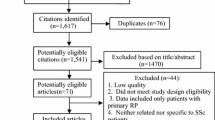Abstract
Cilostazol is a selective inhibitor of phosphodiesterase-III with antiplatelet, antithrombotic and vasodilating properties. The aim of our study was to evaluate the effect of the drug on vasculopathy and Raynaud’s phenomenon (RP), in a series of patients with systemic sclerosis (SSc), before and after cilostazol treatment. Twenty-one consecutive SSc patients with moderate or severe RP were enrolled in an open-label study. Cilostazol was administered at the dose of 100 mg twice a day, for 12 months. Evaluations included: daily RP attack diary documenting the frequency and duration of RP episodes, Health Assessment Questionnaire-Disability Index, scleroderma visual analogue scales (VAS), flow-mediated dilation and immunological status, including endothelin 1 and interleukin 6 plasma levels. Thirteen patients completed the study. RP duration and daily number episodes recorded over a 3-week period significantly decreased after cilostazol treatment (p = 0.0049 and p = 0.0067, respectively). VAS score indicated a significant amelioration of the patients’ perception of RP (p = 0.0117), and both baseline and post-ischemic brachial artery diameters were significantly increased after cilostazol treatment, as compared with basal values (p = 0.0119 and p = 0.0076, respectively). None of the patients developed digital ulcers during the study. A significant clinical improvement of RP was recorded in SSc patients undergoing cilostazol treatment. Study results indicate a potential role of cilostazol as oral maintenance therapy in SSc patients with RP.



Similar content being viewed by others
References
Gabrielli A, Avvedimento EV, Krieg T. Scleroderma. N Engl J Med. 2009;360:1989–2003.
Goundry B, Bell L, Langtree M, Moorthy A. Diagnosis and management of Raynaud’s phenomenon. BMJ. 2012;344:e289.
Prete M, Fatone MC, Favoino E, Perosa F. Raynaud’s phenomenon: from molecular pathogenesis to therapy. Autoimmun Rev. 2014;13:655–67.
Baumhakel M, Bohm M. Recent achievements in the management of Raynaud’s phenomenon. Vasc Health Risk Manag. 2010;6:207–14.
Levien TL. Advances in the treatment of Raynaud’s phenomenon. Vasc Health Risk Manag. 2010;6:167–77.
Kowal-Bielecka O, Landewe R, Avouac J, et al. EULAR recommendations for the treatment of systemic sclerosis: a report from the EULAR Scleroderma Trials and Research Group (EUSTAR). Ann Rheum Dis. 2009;68:620–8.
Caramaschi P, Dalla Gassa A, Prati D, et al. Severe vascular complications in patients affected by systemic sclerosis cyclically treated with iloprost. Rheumatol Int. 2012;32:1933–8.
Kamal AK, Naqvi I, Husain MR, Khealani BA. Cilostazol versus aspirin for secondary prevention of vascular events after stroke of arterial origin. Cochrane Database Syst Rev. 2011;(1):CD008076.
Kanlop N, Chattipakorn S, Chattipakorn N. Effects of cilostazol in the heart. J Cardiovasc Med (Hagerstown). 2011;12:88–95.
Pearce L, Ghosh J, Counsell A, Serracino-Inglott F. Cilostazol and peripheral arterial disease. Expert Opin Pharmacother. 2008;9:2683–90.
Geng DF, Deng J, Jin DM, Wu W, Wang JF. Effect of cilostazol on the progression of carotid intima-media thickness: a meta-analysis of randomized controlled trials. Atherosclerosis. 2012;220:177–83.
Warner CJ, Greaves SW, Larson RJ, et al. Cilostazol is associated with improved outcomes after peripheral endovascular interventions. J Vasc Surg. 2014;59:1607–14.
Rajagopalan S, Pfenninger D, Somers E, et al. Effects of cilostazol in patients with Raynaud’s syndrome. Am J Cardiol. 2003;92:1310–5.
Preliminary criteria for the classification of systemic sclerosis (scleroderma). Subcommittee for scleroderma criteria of the american rheumatism association diagnostic and therapeutic criteria committee. Arthritis Rheum. 1980;23:581–90.
LeRoy EC, Black C, Fleischmajer R, et al. Scleroderma (systemic sclerosis): classification, subsets and pathogenesis. J Rheumatol. 1988;15:202–5.
Merkel PA, Herlyn K, Martin RW, et al. Measuring disease activity and functional status in patients with scleroderma and Raynaud’s phenomenon. Arthritis Rheum. 2002;46:2410–20.
La Montagna G, Cuomo G, Chiarolanza I, Ruocco L. Valentini G [HAQ-DI italian version in systemic sclerosis]. Reumatismo. 2006;58:112–5.
Steen VD, Medsger TA Jr. The value of the health assessment questionnaire and special patient-generated scales to demonstrate change in systemic sclerosis patients over time. Arthritis Rheum. 1997;40:1984–91.
Rollando D, Bezante GP, Sulli A, et al. Brachial artery endothelial-dependent flow-mediated dilation identifies early-stage endothelial dysfunction in systemic sclerosis and correlates with nailfold microvascular impairment. J Rheumatol. 2010;37:1168–73.
Fenoglio D, Battaglia F, Parodi A, et al. Alteration of Th17 and Treg cell subpopulations co-exist in patients affected with systemic sclerosis. Clin Immunol. 2011;139(3):249–57.
De Franciscis S, Gallelli L, Battaglia L, et al. Cilostazol prevents foot ulcers in diabetic patients with peripheral vascular disease. Int Wound J. 2015;12(3):250–3.
Kim WU, Min SY, Cho ML, et al. Elevated matrix metalloproteinase-9 in patients with systemic sclerosis. Arthritis Res Ther. 2005;7:R71–9.
Acknowledgments
This work was supported by Grants from: “Gruppo Italiano Lotta alla Sclerodermia (GILS).” The sponsors had no role in study design, in the collection, analysis and interpretation of data, in the writing of the report, and in the decision to submit the article for publication.
Conflict of interest
None.
Author information
Authors and Affiliations
Corresponding author
Additional information
Gilberto Filaci and Francesco Puppo have contributed equally to this paper.
Rights and permissions
About this article
Cite this article
Negrini, S., Spanò, F., Penza, E. et al. Efficacy of cilostazol for the treatment of Raynaud’s phenomenon in systemic sclerosis patients. Clin Exp Med 16, 407–412 (2016). https://doi.org/10.1007/s10238-015-0370-5
Received:
Accepted:
Published:
Issue Date:
DOI: https://doi.org/10.1007/s10238-015-0370-5




